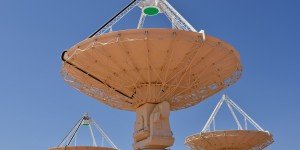Blog Archives
-
Insights into binary black hole formation from gravitational waves
Wed 01 Nov, 2017 @12PM, Level 7 Dr. Simon Stevenson, OzGrav postdoctoral fellow Swinburne University Email: spstevenson[at]swin.edu.au Abstract In its first observing run (O1), Advanced LIGO …
astro.physics.unimelb.edu.au/2017/11/01/insights-into-binary-black-hole-formation-from-gravitational-waves
-
Probing Fundamental Physics with Strong Gravitational Lensing
Wed 25 Oct, 2017 @12PM, Level 7 Dr. Thomas Collett, Dennis Sciama Fellow Institute of Cosmology & Gravitation (ICG), Univ. of Portsmouth Email: thomas.collett[at]port.ac.uk Abstract Local …
astro.physics.unimelb.edu.au/2017/10/25/probing-fundamental-physics-with-strong-gravitational-lensing
-
How standard is the standard candle?
Wed 11 Oct, 2017 @12PM, Level 7 Prof. Jeremy Mould, Professor Swinburne University Email: jmould[at]swin.edu.au Abstract Over 25 years ago New York Times science writer Dennis …
astro.physics.unimelb.edu.au/2017/10/10/how-standard-is-the-standard-candle
-
HI and metal absorption lines during the Epoch of Reionization
Wed 04 Oct, 2017 @12PM, Level 7 Luz Ángela Garcia, PhD student Swinburne University Email: lgarcia[at]swin.edu.au Abstract In this work, we study the epoch of Reionization …
astro.physics.unimelb.edu.au/2017/10/03/hi-and-metal-absorption-lines-during-the-epoch-of-reionization
-
Stochastic gravitational waves in the reach of aLIGO?
Wed 27 Sep, 2017 @12PM, Level 7 Prof. Csaba Balazs, Professor Monash University Email: csaba.balazs[at]monash.edu Abstract Based on a scalar singlet extension of the Standard Model …
astro.physics.unimelb.edu.au/2017/09/26/stochastic-gravitational-waves-in-the-reach-of-aligo
-
The many lives of AGN II: the formation and evolution of radio jets and their impact on galaxy evolution
Wed 20 Sep, 2017 @12PM, Level 7 Prof. Darren Croton, Professor Swinburne University Email: dcroton[at]astro.swin.edu.au Abstract In this talk i describe new efforts to model radio …
astro.physics.unimelb.edu.au/2017/09/11/the-many-lives-of-agn-ii-the-formation-and-evolution-of-radio-jets-and-their-impact-on-galaxy-evolution
-
Shining a light on planetary processes
Wed 13 Sep, 2017 @12PM, level 7 Dr. Helen Brand, Scientist – Powder Diffraction Australian Synchrotron Email: helen.brand[at]synchrotron.org.au Abstract Jarosites and related minerals are of great …
astro.physics.unimelb.edu.au/2017/08/18/shining-a-light-on-planetary-processes
-
After GW150914: gravitational-wave astronomy in the era of routine detection
Wed 30 Aug, 2017 @12PM, level 7 Dr. Eric Thrane, Senior Lecturer Monash University Email: eric.thrane[a]monash.edu Abstract The first detection of gravitational waves from merging black …
astro.physics.unimelb.edu.au/2017/08/18/after-gw150914-gravitational-wave-astronomy-in-the-era-of-routine-detection
-
Modelling thermonuclear supernovae: how to blow up a white dwarf star
Wed 09 Aug, 2017 @12PM, level 7 Dr. Stuart Sim, Lecturer/Associate Investigator (SkyMapper) Queen’s University Belfast, UK Email: s.sim[at]qub.ac.uk Abstract Aside from being spectacular displays in …
astro.physics.unimelb.edu.au/2017/08/18/modelling-thermonuclear-supernovae-how-to-blow-up-a-white-dwarf-star
-
Galaxies at Cosmic Dawn: Exploring the First Billion Years with Hubble and Spitzer – Implications for JWST
Wed 02 Aug, 2017 @12PM, level 7 Prof. Garth Illingworth, Professor University of California Santa CruzEmail: gedi[at]ucolick.org Abstract Hubble has revolutionized the discovery and study of …
astro.physics.unimelb.edu.au/2017/08/18/galaxies-at-cosmic-dawn-exploring-the-first-billion-years-with-hubble-and-spitzer-implications-for-jwst
-
Star formation quenching in cluster galaxies from integrated and spatially resolved spectra
Abstract
The distribution of galaxy properties such as colors, morphologies, and star formation rates is broadly bimodal, with early type galaxies being statistically red and quiescent, and late type galaxies being blue and actively star forming. When, why and how galaxies become passive is a crucial question in modern astrophysics, and might be related to both the galaxy intrinsic properties, and to the environment in which galaxies live. In particular, the cluster/denser environments are particularly efficient in quenching the star formation and therefore represent an ideal place where investigating galaxy properties. I will present the results that we obtained by studying a large sample of low-redshift clusters for which we have been able to characterize the different populations of galaxies on their way to become passive. I will also report on the Eso GASP Large Program, that is devoted to the study of a sample of cluster and field galaxies that show signatures of gas stripping at various degrees. GASP makes use of the MUSE IFU spectrograph at VLT, and has already observed ~50% of its targets. I will show the results that we have obtained so far for jellyfish galaxies, and I will briefly report on the emerging connection between jellyfish galaxies and AGN activity in cluster galaxies.
astro.physics.unimelb.edu.au/2017/08/04/dr-_alessia_moretti-html
-
HI and metal absorption lines during the Epoch of Reionization
Abstract
The distribution of galaxy properties such as colors, morphologies, and star formation rates is broadly bimodal, with early type galaxies being statistically red and quiescent, and late type galaxies being blue and actively star forming. When, why and how galaxies become passive is a crucial question in modern astrophysics, and might be related to both the galaxy intrinsic properties, and to the environment in which galaxies live. In particular, the cluster/denser environments are particularly efficient in quenching the star formation and therefore represent an ideal place where investigating galaxy properties. I will present the results that we obtained by studying a large sample of low-redshift clusters for which we have been able to characterize the different populations of galaxies on their way to become passive. I will also report on the Eso GASP Large Program, that is devoted to the study of a sample of cluster and field galaxies that show signatures of gas stripping at various degrees. GASP makes use of the MUSE IFU spectrograph at VLT, and has already observed ~50% of its targets. I will show the results that we have obtained so far for jellyfish galaxies, and I will briefly report on the emerging connection between jellyfish galaxies and AGN activity in cluster galaxies.
astro.physics.unimelb.edu.au/2017/08/04/luz_angela-html
-
Testing for tensions between datasets

In cosmology, as in other areas of astrophysics, we are constrained to make observations of unrepeatable events (such as the Big Bang), and so have to …
astro.physics.unimelb.edu.au/2017/06/06/colloquium-by-david-parkinson
-
Welcome to the Astro Research Group!

The Melbourne Astro group has weekly colloquia, group meetings, and journal clubs. Normal times and places can be found on the calendar here. A list of …
astro.physics.unimelb.edu.au/2016/06/24/welcome-to-the-astro-research-group
Number of posts found: 194